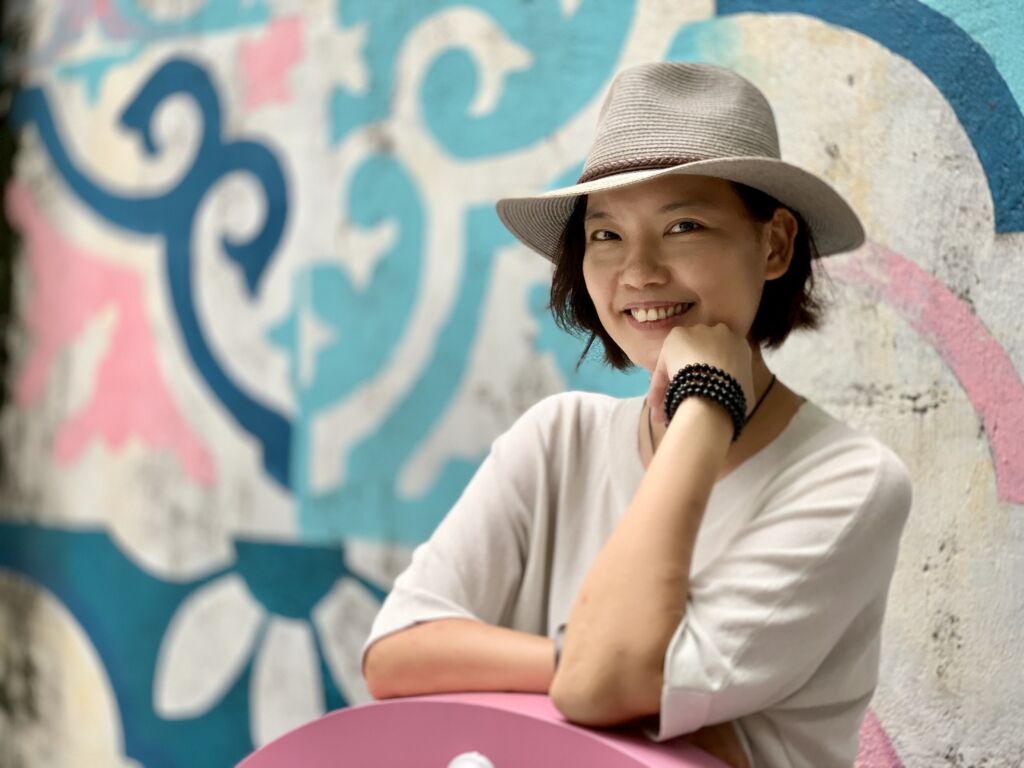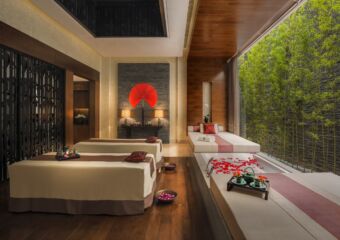France seems to have always been part of Alice Kok’s life: in primary school, she wanted to study astronomy in France. She ended up going to college there and lived in France for eight years. Buddhism and meditation are a huge part of her being. Although vegetarian, Alice eats cheese. After all, she’s a bit French as well. Born in Macau in 1978, Alice Kok is one of the city’s most relevant names when it comes to putting contemporary art talents out there. She’s been living between Lhasa, Tibet and Macau for more than a decade, dedicating her time to a local art association, her own exhibitions, literature, and other projects. Currently writing a book, she also presides over Art For All Society and curates exhibitions.
Alice has a remarkable life story and we got to know her a little bit better during a chat at Macau Art Garden’s cafe. Read on and find out more about her life achievements, how she combined karaoke with a French twist, how important Buddhism is for her, and more.
For our readers to know Alice Kok better: what are you currently working on?
Apart from being an artist, I also work at the local art association, AFA–Art For All Society–which I’ve been presiding it for the last six years. There is a new structure coming up. I’ve been working on presenting my candidacy for this year. Also, the team structure has undergone major changes. There are new generations of artists coming in, some older artists decided they wouldn’t go on being members of the board. That’s what I’ve been doing now, including curating AFA’s exhibitions.
I split my residence and time between Macau and Tibet. My daughter is studying in K2 back in Lhasa; the plan was that I would bring her here during winter holidays (which are extensive because of the cold weather) and after Chinese New Year, her father would come to pick her up for her to go back to school in March. However, this year, as school hasn’t started, she’s staying here with me.
How often do you come to Macau?
I come to Macau every two months and usually stay for two, three weeks. I also work online. I come for AFA, but also for the Macau Literary Festival, Art Fem, and the Women Artists International Biennial, founded by Carlos Marreiros. He invited me to be one of the biennial’s curators. Unfortunately, because of the COVID situation, both events were postponed. In a way, it was also COVID that made me stay in Macau for longer, so I’m taking this extra time to take care of everything in AFA, and others.
Every time I come back to Macau, I’m very busy because there’s so much to deal with in a very short period of time. It’s actually quite extreme. When I’m here, I’m super busy and when I go back to Tibet, it’s the contrary. I’m writing a book and whenever I go back, I get to appreciate the silence and the air… It’s good to write and concentrate.
When it comes to art, what are your preferred mediums?
I think I don’t really mind a specific one; I like all of them. I have a drawing background–I loved drawing when I was young–and sketching, but when I was studying art in France, I started shifting into something more visual, related to images. Nowadays, I work a lot with the power of the image; it can be photography, video. I’ve been experimenting with drawing for my upcoming exhibition in June, to create a kind of a laboratory, invite students of art to join us, do calligraphy, sketching, meditation…If you ask what’s my preferred medium of creation, I’d actually say it’s meditation.
There’s a very wide and deep creative space in meditation and within that space, any form could be possible. I don’t limit myself to any kind of specific media.
So meditation is an important part of your life?
Yes. I’ve been doing meditation since 2007.
Did you start in Tibet?
Actually, I started in France, after my master’s degree, when I started being interested in Buddhism and meditation. However, at the time, I didn’t really manage nor got into it. In 2006 and 2007, I went to India and that’s when I met my meditation teacher–he’s Tibetan. In Tibetan Buddhism, meditation is a one-on-one teacher-student practice. I read books, shared my life experience and everything.
Why did you go to India in the first place?
It was related to an art project of mine, “Yet in Exile – Family Script”.
Before splitting your time between Macau and Tibet, you used to live in France. What made you go abroad?
Since I was a kid that I always dreamt about foreign lands. It’s probably in my character and also, I’m an earth horse (Chinese horoscope) and we have a saying: “the horse who traces thousands of miles”; it must be something related to this. I enjoy traveling very much and love to shift places from time to time. I think that if I was always in one place, I’d be super bored, I’d feel stuck, which I hate. Also, my family always told me my father always wanted to study abroad but he never got the chance because his family didn’t have money to support him. My father worked hard for all his life to support us and give us a good life. They always told us we have to experiment, travel, study abroad; they valued studies and education very much, always encouraged us to pursue our academic wishes. In the beginning, my mother wasn’t expecting I was going to go to arts (laughs), because it’s usually linked to people who never get rich.
And do you think this is true?
Well, I’m the living proof of that (laughs), but I have a rich life. I don’t have a full-time job or a regular salary and I’ve been freelancing for nine years already. I manage it and although I’m not rich, I really don’t feel like I’m lacking anything. I don’t have a stable income, but at the same time, I feel I can enjoy my time and manage it well. This is very valuable for me.
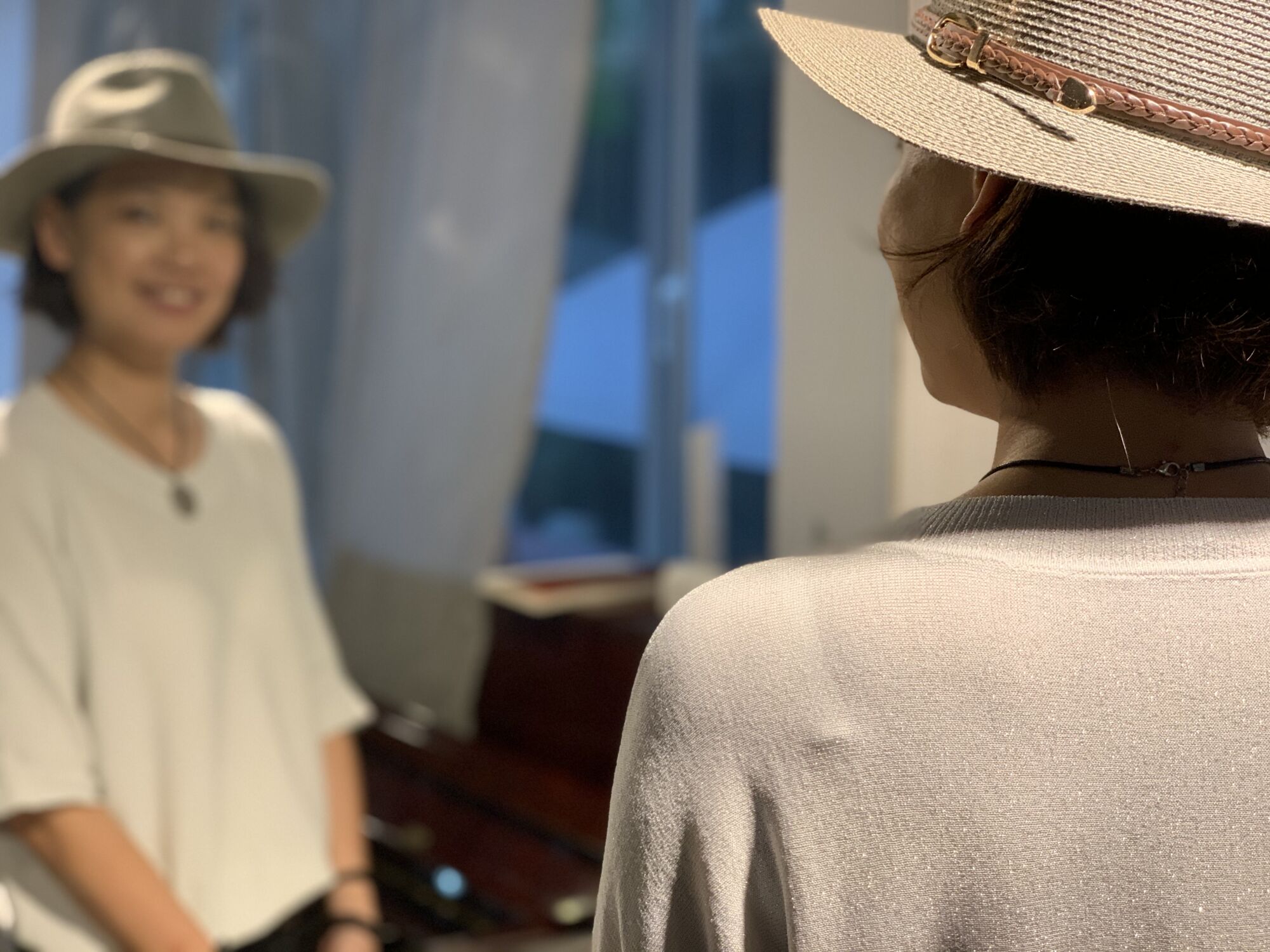
Why start with France, specifically?
It’s quite funny, actually. When I was in primary school and all those questions of “what do you want to be when you grow up?”, my answer would be “Go to France to study astronomy” (laughs). I wanted to be a scientist at the time. In high school, I started changing my mind because I was in an English school and to go to France, I’d have to learn the language. It’d be easier to study in the UK, so that was my goal then.
When I was in my senior year of high school, I started applying for colleges in England and chose Bradford. The brochure looked so nice! I wanted to study architecture. I’m very good at maths and science, my father was also in the construction business–it was kind of a logical choice. However, at that same time, I met the guy who’d be my boyfriend and he was really encouraging, always telling me I should pursue my dreams, go to France to study arts. Partly because of the idea of being able to study what I really wanted and because I didn’t want to lose him, I stayed one more year in Macau to really decide what I wanted. The Macau Polytechnic Institute had an art department focusing on graphic design, so I applied, got in, and excelled in school that year. That’s where I met my photography teacher as well. I knew I didn’t want to do graphic design, so I got the taste of it, which assured me I really wanted to pursue arts. That’s when I went to France to study art. My photography teacher had also studied there, my boyfriend was French… it made total sense! I visited France before applying to schools and loved it and learned French in a year while there. I finished my master’s from the Toulouse School of Fine Arts in 2004.
Did you return to Macau afterward?
I lived in France for eight years, and before coming back to Macau, I traveled extensively through India and Tibet and did my “Yet in Exile – Family Script” project. I came back to Macau in 2007.
Do you believe your experiences abroad shaped your art?
Totally. When I was a kid, I was educated in Macau schools. When I was in middle school, I learned all about Japanese manga–even took a course. My style was very limited to it. It was in the Polytechnic that I understood, with my photography teacher, that I understood art is much larger than just manga. The same happened in France. Since then, I’ve learned a new language, took several years of studying and everything. My bachelor’s and master’s degree is what they call in French, “plastic arts”, like fine arts.
Nowadays, for me, it’s not about the medium anymore; they emphasized a lot on art theory, especially in France, where the philosophy and tradition of art critics is so strong. The real professors don’t teach you how to draw or make a video; they encourage you to develop independent thinking. That’s the key: developing a method or process of work. It’s not about techniques–which is also very important–but how we see the world and how we transform these views and perspectives into artworks.
It even shaped the way I teach art here in Macau. I don’t say that people should only focus on one media; even when I’m teaching a photography course, I talk about art in general, about how we see images, and more. The main thing is: what is an image? What’s the value you attribute to it? It’s important to have critical thinking, to know what we’re exposed to.
What did your master’s exam entail?
We had a gallery space that looked like a museum. The exam was to have a solo exhibition in that space, which is a big challenge. You have to explain your method of work to a group of juries that don’t know you–the degree is given by the national cultural department, not by the school. Philosopher’s, art critics, historians come and start questioning you about your exhibition. My thesis was about multiculturalism in the post-colonial epoch.
I created a piece called “Le Tableau”. I was very much into philosophy and one day, I was just sitting in my studio, thinking about the thesis, the subject and suddenly, a sentence popped into my mind: “Le limit de ce tableau est le monde”, which literally means “the limit of this painting is the world”.
I wanted to make a piece that involved karaoke because I wanted something related to my childhood and that was it. When it was imported from Japan, in the 80s, it was really popular in bars, but also in people’s homes! It might be one of the things I remember most from my childhood. The laserdiscs, the mic…everything! All these songs from popular Hong Kong culture. Very easygoing, romantic melodies, those cheesy videos in the background. For me, it was a social phenomenon. It was part of our culture or at least a symptom of it. I decided to make a song out of that French sentence. I wanted something that wasn’t taken literally but with some kind of irony attached to it. I asked a French classmate who was studying music to compose a song with an 80s melody. I didn’t want to sing it in French, I wanted it in Cantonese. But how would I translate such philosophical sentences?
In Macau, streets are translated with the literal phonetic translation of the Portuguese, thus they bear no meaning, it’s just the same sound as the Portuguese; it’s an imitation. So I did exactly the same with my song: each sound of “la limit de ce tableau est le monde” has a corresponding Cantonese word. Cantonese is a very rich language in terms of sound. Almost every sound you make, I can give you a word.
I then translated it literally to Cantonese and sang it. It does have a meaning in Chinese, but it’s absurd: “hitting a pineapple with tears” (laughs). I made the karaoke with music and lyrics, exhibited it at Creative Macau at the time, and invited locals to sing it. They were basically singing “hitting a pineapple with tears”, but it’s much more than this.
The exhibition was called “Misleading” because they’re supposed to be singing in French, but it’s in fact Cantonese. When they sing these Cantonese words, it becomes Cantonese but then I got back to France, showed the video, and people were supposed to hear Cantonese, but they recognized French because it does sound like it. It’s almost like lost in translation. If people are different from each other, they can never be the same, that was my master’s degree idea. It was about respecting each other’s differences. Art is that gap in between, that space in which we can play. I say “hitting a pineapple with tears”, but you hear “le tableau”.
Focused on which culture?
When I was in France, I started to question “where am I from?” and at the time, no one knew where Macau was. When I told people it was a colony for centuries, they were really surprised such a place still existed. When I came for holidays, I took it in with a set of new eyes, I saw it differently, now that I was studying abroad. The thesis was about Macau and its multicultural background, and what that represented for the city at the end of the 90s.
The French educational system is quite traditional. How did the jury react to it?
It didn’t go so well. I remember they were challenging and questioning me about everything, constantly asking what my references were. I created it in a very unconventional way, actually. I didn’t want to present myself as a French artist but as myself. “You’re passing an exam in France and you have to give us references as our school’s mandate”, they said. We argued a bit, I said “Art can be life, life can be art” and two of the jurors just said, “that’s not possible”. So it was hard, but I got my degree because of my work process, according to them.
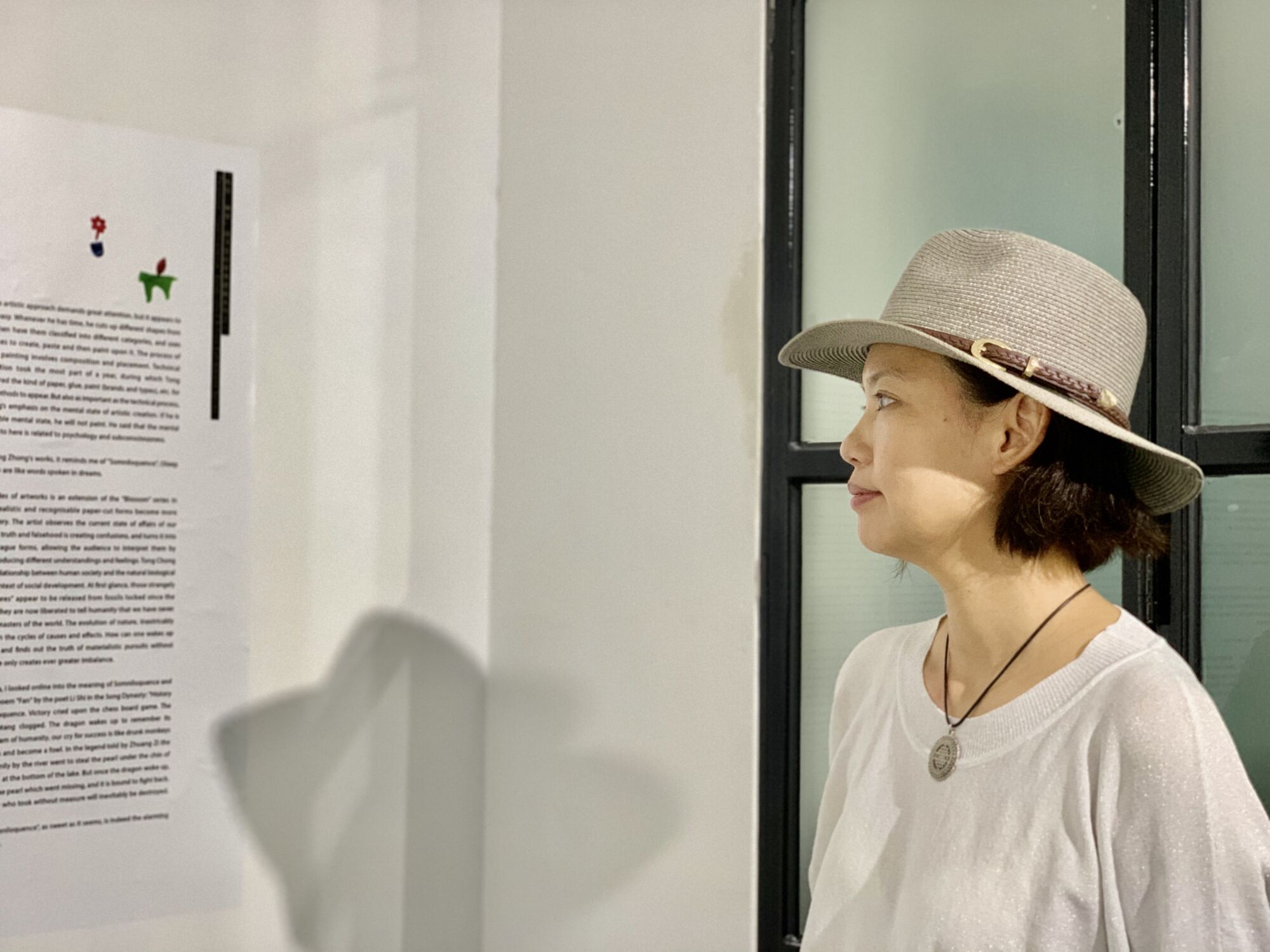
Where did you go after finishing your master’s?
I wanted to prove I was able to do art in the ways I wanted to, that it didn’t have to be formal. So I went to Paris and worked there for some time. I did a project called Karabic OK and was awarded for it. It’s basically the La Marseillaise (French anthem) sang in Arabic. I ended up living in France for eight years: two in Limoges, four in Toulouse and two more in Paris.
Could you tell us why?
A national anthem is never sung in another language, right? I searched online and translated version from 1914; the French were colonizing the north of Africa and trained the Arabs to fight for them as a nation, hence teaching them the national anthem as well. So this project is about colonization as well. I sent the proposal, they gave me a grant, went to Macau and filmed it. It was when Macau started opening up the gambling industry, which resulted in a video with Chinese, Arab, Portuguese, and Las Vegas in the background.
I filmed the northern area of Macau because I wanted to show people what’s our city made of. I brought it back to France and they loved it, I exhibited it, even sang it on French national radio, and Le Monde wrote about my work. At the time (2006/2007), Arab youngsters were burning up cars, which was during the time I was filming this; there was a lot of tension between Arabs living in France and locals. But they’re also part of the country and that’s one of the reasons I love France: because it’s multicultural. Singing the national anthem in Arabic on the radio was the proof I needed for my master’s jurors.
From Paris to Lhasa is a long way. How did the idea of Tibet come about?
I explored the Macau and Arab issues then wanted to know what happened in Tibet, which was kind of a sensitive matter. I went to India first because there’s a big Tibetan community that lives there and stayed there for some time. I volunteered to teach English at a refugee camp, with a community of women who sewed handmade carpets and lived on this trade. They left Tibet when they were young, during the 80s with family members; they believed if they went to India and met the Dalai Lama, they would be blessed and have a better life.
Yet in Exile – Family Script is one of your life projects. Can you tell us a bit about it?
It goes back to my master’s degree work, my final project exam. Some of these family members [in Tibet and India] haven’t seen each other for decades, so I connected them through videos I did in India and Tibet.
Was that journey a solo one?
Yes. Well, I met some friends along the way, but it was a solo trip. I met a Chinese amateur photographer who gained an interest in the project and decided to help me. I was quite lucky because I needed some help when it comes to understanding the (Chinese in Tibet) culture and everything. My critical years took place in France, so going to Tibet, staying with a Han Chinese from the mainland, was a bit difficult at the start. His help was crucial and I started understanding the people better. I feel I’ve always been very lucky.
So the project was about connecting people?
It was about families and making connections between people. I then traveled through Tibet and it was harsh–it was the middle of winter–and the journey of my life. I spent three months there and it was amazing, I have so many beautiful stories. I got eleven families to reach out and back in India, I asked all of them to give me a phone number so I can contact people when I got to Tibet.
However, the eleventh family’s phone number had an extra number, so I couldn’t contact the members. The only thing we had was a surname and the town’s name. We (Alice and her friend) were running out of money and in the town looking for that person, but it was really difficult because it was a remote little village and the population wasn’t very forthcoming. A guy playing pool just pointed “up” to the mountain when we asked for the surname; as we started going our way, I saw a Tibetan tea shop and said, “Let’s go in there and ask”. My friend was getting impatient, just wanting to be finished with it. However, I convinced him. We entered the tea shop, asked the man inside and he replied: “I am him”. I went with my gut and that’s what happened.
Have you been living like that since then?
Yes, I always follow my instincts. I had a dream about my husband and then I met him. Before I met my current husband, I dreamt I’d met someone and divorce my French husband. And that’s what happened. I strongly believe that whatever happens is supposed to happen; trust everything and everybody you connect with.
My life has been changing a lot. I used to struggle a lot in France; I was depressed, I was very troubled and couldn’t find my way out. I saw doctors, they gave me pills. One of them told me “go with your art, you don’t need pills”. However, it was only when I came across Tibetan Buddhism and meditation that I felt completed cured.
In what way did it change you?
It actually changed my brain. You can’t meditate just once or twice, it’s something that has to become part of your daily routine. The meditation itself isn’t the goal: the path is the goal. It’s about the post-meditation when you’re with people, you’re out in the world. Meditation helps you to be present, not think about the past or the future. It’s the “now”.
It made my relationship with people and my work something very natural and sincere, with quality. That’s what I feel is important.
How is a normal day for you in Tibet?
My daughter goes to school at 9:00am, so we wake up around 8:00am and my husband drives her to school. I stay home, have breakfast. We’re all vegetarian, so I’ll cook my daughter’s lunch and my husband takes it to school. From noon up to 5:00pm, I write. I’m writing a book. These are my five hours of “me time”. I then cook again–dinner–and then go to sleep around 11:00pm.
Do you include meditation in this routine?
Yes. 30 or 40 minutes, an hour of meditation always before I start my writing.
Buddhism also perspires into your art. Is it about the philosophy behind it, the religion?
It’s the way of living, of creating. When I was in France, I was very conceptual, strongly influenced by the art of the 60s. I was very linguistic, intellectual; it was about finding new ideas and depending on being smart and witty. However, “Family Script” and meditation changed that. I don’t need the wit anymore; I’m aiming more toward wisdom now (laughs). Now, I create, I don’t really try finding the perfect idea. It’s more about meditating and letting it come. It comes as images and feelings. My last exhibition [2018], called “Emptiness Is Form”, started being created just two months before. I researched the theme–about emptiness and form focused on the heart sutra–and centered on the famous sentence “emptiness is form and form is emptiness”.
I wanted to work on this idea and gave shape to emptiness, basically. This was heavily based on intuition. I bought lots of (picture) frames and saw, while meditating, all these frames become the word “le tableau” in Chinese character: 圖 (it means picture or image)
That’s my theme. The one I created for this exhibition is the new version of Karaoke’s “tableau”. Ten years ago, I did it for my master’s degree; in 2018 I reinvented it. It’s not about being beautiful, it’s more about what it means.
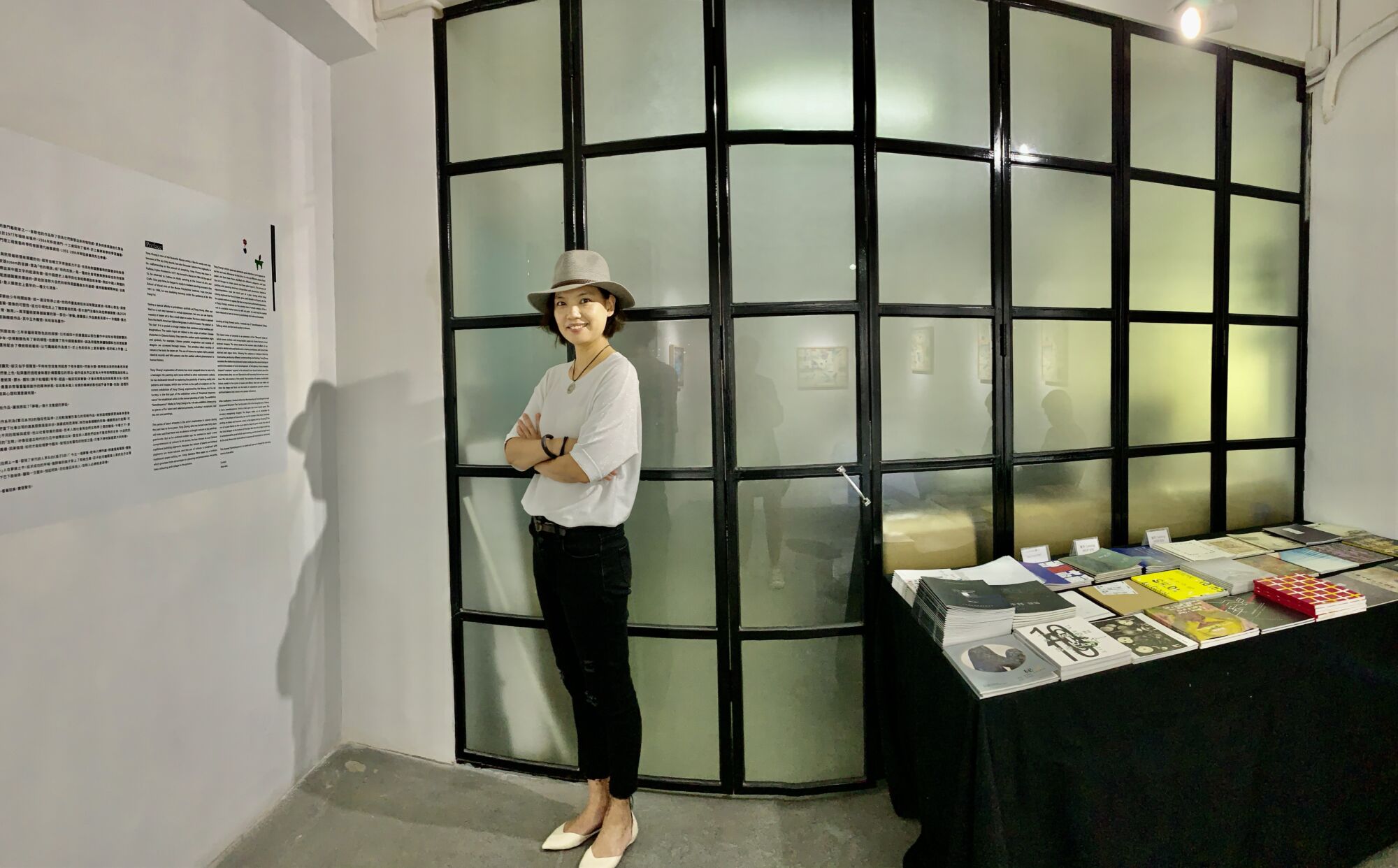
Is Lhasa a developed city?
It’s the capital of Tibet, so yes. It’s the same size as Macau and it’s becoming more and more developed, but not as much as Macau. Most buildings are about four or five stories high.
Is it a place of inspiration for you?
Sure. Actually, I wanted my next photography exhibition to be there, but now it’s not possible. It’s always a very inspirational place for me, also when it comes to writing. This is also a very demanding task.
What’s the book about?
My life story. It’s going to be published in Chinese and English as well, I believe.
What about Macau? Does it inspire you?
Now, my inspiration comes from within. It doesn’t really matter where I am. I still have that in me, anywhere I am. Of course, it inspires me in the way I practice my art here (in Macau). I connect to people here, also have professional projects.
What about ideas the city can provide?
Maybe in the future. I don’t create art every day. I’m very project-oriented. If I’m working on a curating project, I don’t get involved in my art during that period. Since I’ll be in Macau these coming months, probably my next exhibition will have some of the city in it.
How did you get involved with AFA?
At AFA, we have 59 members, which contrasts with the ones we had at the very beginning. 13 years ago, in 2007, there were six founding members. From then to now, it’s grown 10 times more. I was back in Macau (from India) when the association was founded, and James Chu (one of the founders) approached me about becoming a part of it, invited me to curate his first exhibition at AFA.
Was your plan to come back after finishing “Yet in Exile – Family Script”?
The idea was to go back to Paris afterward, but I had an accident, fell down from some mountains on the way back from India, and was in a coma–I almost died. My sister brought me back to Macau and I couldn’t go back to France then, I was too fragile. I stayed in Macau, was looking for jobs, and started working at Macau Closer magazine. But still kept looking for more jobs because I wanted to make use of the fact that I was alive!
Can artists apply to be part of AFA or do they have to be invited?
People can apply and we, as a committee, decide who gets to be part of it. Our main criteria are artists with an academic background in arts, as well as professional artists, especially focusing on contemporary art. I believe this is quite a specific art form and that in Macau, we are one of the most representative when it comes to contemporary art.
What’s your role as the president?
My team does the annual planning (a program of exhibitions) and plan, every year around August or September, for funding from the government. I also decide on the exhibitions, what artists we exhibit.
What are your plans for the association, now that you’ve been elected president again?
My plan is to stay for another term to prepare the next leadership team. The younger generations are now finishing their academic degrees and returning to Macau; it’s time to bring them in. An association is made of people, not one person only. I feel we need to restructure. Some people leave, others come in, so I have to prepare and be the connection between these changes.
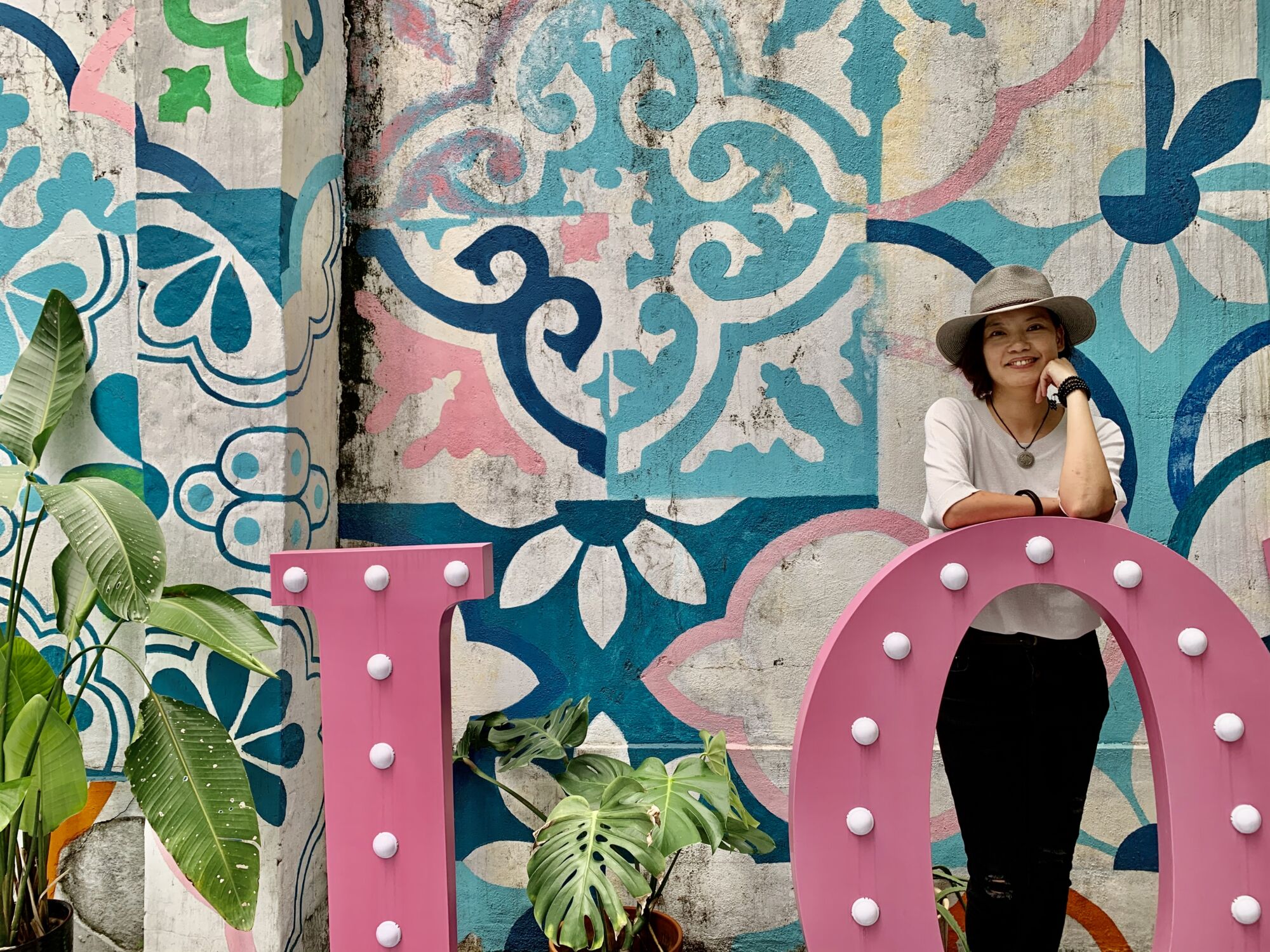
How important is an association like AFA in Macau?
In Macau, we cannot really survive without an association. There’s not a market yet, and there’s not even a clear cultural policy to support the artists. An association is important to support them. Macau is small and even in terms of number, I think the city is lucky enough to be rich, even when it comes to resources. Residents have a lot of benefits. For a small place to have around 60 artists–many working as full-time artists–are very good odds. Since we lack the market and cultural policies, the association works as a platform for us to group resources and voice our needs and suggestions to the government, the policymakers. It’s hard to do this as an individual artist. We don’t have a developed system like the French one, for example. It’s not organic yet.
But it must also be interesting to be working in the development of the arts scene in such an early stage?
That’s exactly why I decided to stay. I worked in France for a few years and realized Macau might need me more than they (in France) did. Times are changing; I might’ve been one of the few at the time to study abroad, but nowadays it’s different.
How would you describe the Macau environment for artists?
It’s been flourishing and you see there are exhibitions somewhere every month. However, being an artist here is kind of comfortable, and society is complacent to a certain extent. We don’t see many substantial artworks happening, because it usually happens when there’s a crisis or challenges. There’s a lot of pretty, beautiful art, but not much of it is substantial. It stays on the surface and the artist might not feel the need to go deeper (in the artworks).
When you’re not working, how do you spend your free time?
I exercise–do gym, yoga, meditate, go to sauna–spend time with my daughter and my family. I work at the Art Garden from Monday to Friday and keep weekends for family.
What is your favorite place in Macau?
I like Lin Fung Temple. It’s my favorite place! I go there every time I need to get an oracle reading. I burn incense as well. It’s not touristic and it’s one of the oldest temples in Macau. The architecture is also beautiful. I think it’s a very spiritual place.
Follow Alice Kok’s work here and follow Art For All Macau’s Facebook page
AFA Macau 1st Floor, Tak Chun Macau Art Garden, Avenida Dr. Rodrigo Rodrigues N. 265, Macau, www.afamacau.com

